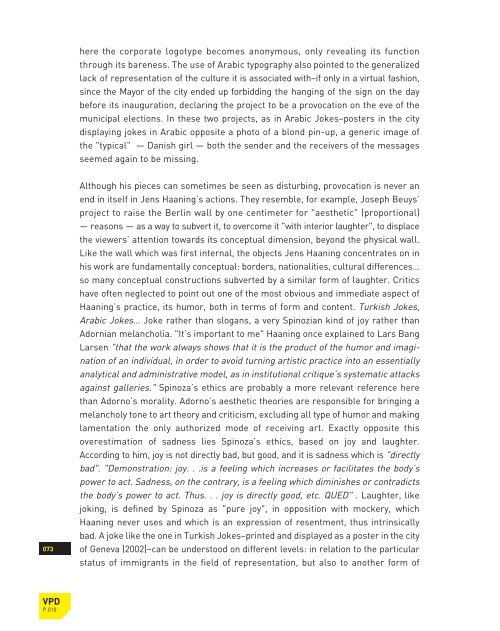download catalogue high resolution pdf (22.3 mb) - Jens Haaning
download catalogue high resolution pdf (22.3 mb) - Jens Haaning
download catalogue high resolution pdf (22.3 mb) - Jens Haaning
Create successful ePaper yourself
Turn your PDF publications into a flip-book with our unique Google optimized e-Paper software.
073<br />
VPD<br />
P.010<br />
here the corporate logotype becomes anonymous, only revealing its function<br />
through its bareness. The use of Arabic typography also pointed to the generalized<br />
lack of representation of the culture it is associated with–if only in a virtual fashion,<br />
since the Mayor of the city ended up forbidding the hanging of the sign on the day<br />
before its inauguration, declaring the project to be a provocation on the eve of the<br />
municipal elections. In these two projects, as in Arabic Jokes–posters in the city<br />
displaying jokes in Arabic opposite a photo of a blond pin-up, a generic image of<br />
the "typical" — Danish girl — both the sender and the receivers of the messages<br />
seemed again to be missing.<br />
Although his pieces can sometimes be seen as disturbing, provocation is never an<br />
end in itself in <strong>Jens</strong> <strong>Haaning</strong>’s actions. They rese<strong>mb</strong>le, for example, Joseph Beuys’<br />
project to raise the Berlin wall by one centimeter for "aesthetic" (proportional)<br />
— reasons — as a way to subvert it, to overcome it "with interior laughter", to displace<br />
the viewers’ attention towards its conceptual dimension, beyond the physical wall.<br />
Like the wall which was first internal, the objects <strong>Jens</strong> <strong>Haaning</strong> concentrates on in<br />
his work are fundamentally conceptual: borders, nationalities, cultural differences…<br />
so many conceptual constructions subverted by a similar form of laughter. Critics<br />
have often neglected to point out one of the most obvious and immediate aspect of<br />
<strong>Haaning</strong>’s practice, its humor, both in terms of form and content. Turkish Jokes,<br />
Arabic Jokes… Joke rather than slogans, a very Spinozian kind of joy rather than<br />
Adornian melancholia. "It’s important to me" <strong>Haaning</strong> once explained to Lars Bang<br />
Larsen "that the work always shows that it is the product of the humor and imagination<br />
of an individual, in order to avoid turning artistic practice into an essentially<br />
analytical and administrative model, as in institutional critique’s systematic attacks<br />
against galleries." Spinoza’s ethics are probably a more relevant reference here<br />
than Adorno’s morality. Adorno’s aesthetic theories are responsible for bringing a<br />
melancholy tone to art theory and criticism, excluding all type of humor and making<br />
lamentation the only authorized mode of receiving art. Exactly opposite this<br />
overestimation of sadness lies Spinoza’s ethics, based on joy and laughter.<br />
According to him, joy is not directly bad, but good, and it is sadness which is "directly<br />
bad". "Demonstration: joy. . .is a feeling which increases or facilitates the body’s<br />
power to act. Sadness, on the contrary, is a feeling which diminishes or contradicts<br />
the body’s power to act. Thus. . . joy is directly good, etc. QUED" . Laughter, like<br />
joking, is defined by Spinoza as "pure joy", in opposition with mockery, which<br />
<strong>Haaning</strong> never uses and which is an expression of resentment, thus intrinsically<br />
bad. A joke like the one in Turkish Jokes–printed and displayed as a poster in the city<br />
of Geneva (2002)–can be understood on different levels: in relation to the particular<br />
status of immigrants in the field of representation, but also to another form of


